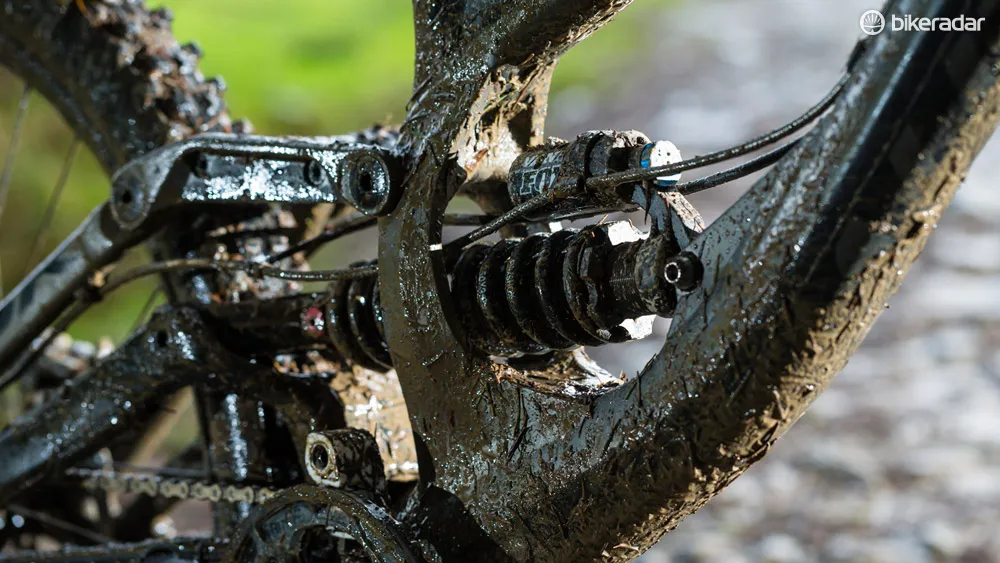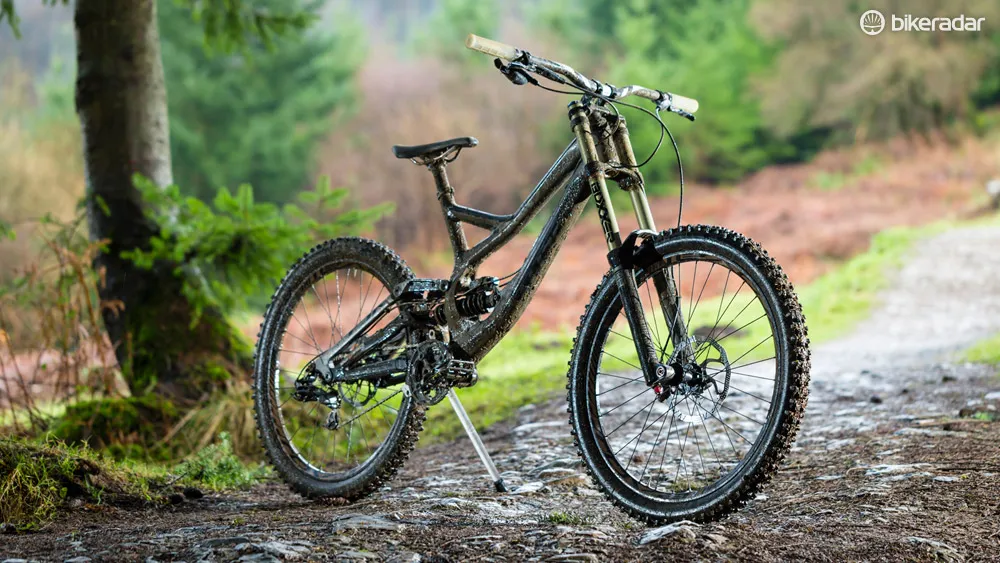The Specialized Demo has been top of many a downhill racer’s wishlist since it was redesigned for 2011. The very slightly altered carbon version may be the dream rig, but this proven aluminium version has remained in the Demo lineup too.
It’s a good value ride, and is the forgetten gem in Specialized’s downhill bike stable.
Frame and equipment: solid and dependable, right through the season
Constructed from Specialized’s M5 alloy, the Demo frame puts out 200mm of travel through Specialized’s FSR platform. The Demo is the only bike in the range to use the twin seatstay style FSR layout, which increases stiffness and creates the suspension kinematics that Specialized wants to achieve.
The Demo uses a yoke to hold the shock in place at the lower end, and each shock manufacturer has a specific yoke to suit their damper’s eyelet – so bear in mind that swapping between shocks will necessitate a quick call to Specialized in order to get the right yoke for the new shock. Inside the shock’s bottom eyelet, sat in the yoke, is an eccentric insert that allows you to adjust the height of the BB by 10mm and the head angle by nearly a degree.

The Fox Van RC shock might be a little basic, but it is a good performer
The frame’s 12x150mm rear end helps to keep the tracking accurate and the rear end stiff, and a 1.5in head tube means you can fit an adjustable headset, should you feel to change the head angle.
Specialized uses a special downhill BB standard, called PF30DH, on the Demo. PF30DH uses a wider shelled press-fit 30 unit and needs specific cranks. Luckily, adaptors for standard BSA threaded cups are easy to come by. Cable routing is all external. This is a good thing on a downhill bike, because it makes emergency repairs easier and saves time on race days.

External cable routing makes race day repairs easier
The Demo 8 I is the cheapest Demo full build. At £3,300 / US$4,400, it represents good value for money when compared to the competition.
A RockShox Boxxer RC fork handles suspension duty up front, while a specially tuned Fox Van RC keeps the back end in check. SRAM’s X9 Type 2 rear mech/derailleur does its job well and keeps the drivetrain quiet. It’s linked to a basic, clunky X7 shifter, which we had to change after it suffered some problems during the test.
SRAM Descendant cranks are solid and dependable performers though, and they help keep the Demo’s overall weight down, and the Gamut P30 chain device keeps the chain safe while taking big hits with ease.
Ride and handling: fun, fast and predictable
The Demo turns as if it’s on rails. The 421mm chainstays, combined with the low 343mm BB height, don’t just make the bike fast, but fun too. You can hammer it into turns flat-out, even on our size large test bike with its long front-centre, and still get that back end in and round the turns with ease. You’ll have a big grin on your face while you’re doing it too.
The fun doesn’t stop there though. The FSR rear end makes easy work of all but the gnarliest sections. Even the somewhat basic Fox Van RC shock was only outwitted on crazily fast, deep, high-speed compressions, where it seemed to falter slightly during its rebound stroke.
We’ve spent lot of time on the Demo with different shocks fitted, and the suspension is pretty hard to fault. The most notable thing with FSR is just how comfortable, predictable and easy to ride it is. We found ourselves hitting sections of trail faster than we ever did before, on bikes we’d been riding for years.
It’s obvious that the designers have put the time into considering the geometry of the Demo. On paper the 64-degree head angle may look a degree steeper than some would prefer, or maybe the BB is too low for truly efficient pedaling, but the Demo is certainly worth throwing a leg over before making judgments based on the numbers alone. The head angle actually measures in at 63.5 degrees with the fork legs dropped through the crowns as far as they’ll go – this also raises the front end a bit and gives a more comfortable position on the bike, especially when you’re heading down steeper trails.
It’s tons of fun and crazy fast everywhere, even on flat-out straight bits of trail where we had concerns about whether the shorter chainstay length would translate to rear-end instability, but we never lacked stability, even through super rough sections, and we could always pop the front wheel up at a millisecond’s notice if something got really in the way.
The sizing is our one gripe with the Demo - our 5ft 8in test rider needed a large size frame to make the most of the bike, so we’d recommend picking a size up from what you’d normally go for. The short chainstay length means wheelbase needs to be made up somewhere, so despite having a top tube length comparable to other bikes, the wheelbase was still slightly short. It’s a shame there’s no XL size in either the alloy or carbon bikes.
The bike’s spec handled the whole test with ease, bar the X7 shifter, which we’re sure is a warranty issue due to the tiny amount of use before it imploded.
The Boxxer RC fork is a reliable performer; to nitpick, it lacks some compression damping control through really harsh stuff, but what it lacks it makes up in confidence inspiring support through the stroke. The Gamut chain device took some crazy hits and shrugged them off, while the Avid Elixir 7 trail brakes still feel as good as they did when they were first set up, even with a fair number of pad changes and even a couple of airline flights thrown in too.
We like that there are direct mount stem spacers included with the bike to lift the front end up too, providing more adjustment to help you get it feeling exactly how you want.


